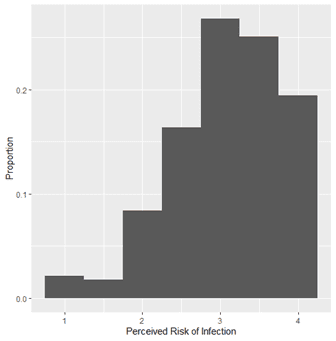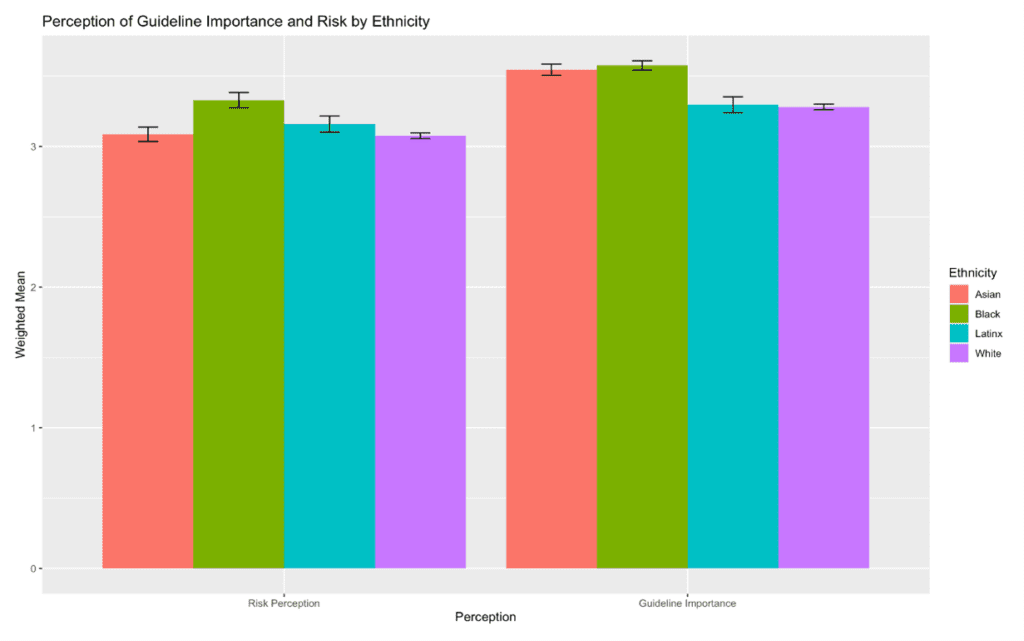In our second report on the Living in Boston During COVID survey, we have focused on contrasting themes of fear and ambivalence among Bostonians. On the one hand, there appears to be broad consensus that the virus is dangerous, that social distancing guidelines are important, about wearing masks and avoiding high-risk activities, and that asymptomatic spread is a concern. However, the proportion of respondents who differed on these views is non-trivial and varies substantially by neighborhood, race, and income. These variations can help us to understand the vulnerabilities that different communities face as cases surge this winter. In today’s data story, the first of four from this report, we focus in on attitudes toward risk and social distancing.
The report included two main measures about attitudes regarding the pandemic: the perceived risk of that certain behaviors posed to the respondent’s health, including being close to others outside of their home and attending gatherings; and the importance of guidelines for social distancing, like staying home as much as possible, specifically how important the respondent felt it was for them and others in their neighborhood to comply with social distancing suggestions and regulations. As we see in Figure 1, the vast majority of people endorsed these notions, stating that there was “moderate” or “large” risk in gatherings and being close to people outside their house and that it was “very” or “extremely” important that everyone in their neighborhood follow the guidelines imposed by the state.


Figure 1. Distribution of attitudes toward the pandemic, including the stated importance of social distancing guidelines (left panel) and the perceived risk of infection of certain behaviors (right panel). Both measures are on a 4-point scale, with 4 equal to highest perceived risk / importance of
Though we see a topline consensus here, we do see that a substantial proportion of respondents were more ambivalent about these notions. This reflects a theme we have seen both locally and nationally, regarding the risk associated with the virus and the need for certain precautions. Unsurprisingly, we see substantial differences in these attitudes across neighborhoods and populations in our survey. These differences appear to track somewhat with questions of equity, but in the sense that communities of color more strongly expressed concerns about infection exposure and endorsed the importance of social distancing guidelines than their White counterparts.


Figure 2. Differences across neighborhoods in perceived risk of infection (left panel) and the importance of social distancing guidelines (right panel). Both measures are on a 4-point scale, with 4 equal to highest perceived risk / importance of guidelines.
We see some clear geographic patterns in the distribution of perceptions of risk and attitudes toward social distancing guidelines (see Figure 2). Respondents from neighborhoods along Boston’s east coast South Boston and the Seaport, North End, and North and South Dorchester—tended to report lower perceptions of risk and that the guidelines were less important. Meanwhile, the majority-minority southern urban core and the southern half of East Boston (i.e., Maverick Square, Jeffries Point) generally reported the highest perception of risk and most strongly endorsed social distancing guidelines. This aligns with the higher infection rates in these neighborhoods[1], as well as the findings in the first report in this series[2] that they were more often in positions that exposed them to more risk.
A third group of more affluent, Whiter neighborhoods stood out from these other two groups as they did express lower levels of perception of risk but strongly endorsed social distancing guidelines. These included Jamaica Plain, Roslindale, Hyde Park, Back Bay, Beacon Hill, the southern half of East Boston, and Brighton. This might point to a belief that social distancing mechanisms are important but that those neighborhoods did not suffer from as high of infection rates nor the inequities that might have created a greater sense of risk.
As we translate these geographic differences to demographics, it is unsurprising to see in Figure 4 that White respondents on average had the lowest concern about risk and saw the least value in social distancing guidelines. It is important to note, however, that because most scores on each scale were quite high, this reflects greater variation in attitudes across White respondents.
Two other features stand out as well. First, Black respondents on average expressed the strongest concerns regarding risk of infection and endorsements of guidelines, joined in the latter by Asian respondents. Meanwhile, Latinx respondents were closer to their White counterparts in their attitudes toward social distancing guidelines.

Figure 3. Differences by ethnic background in perceived risk of infection (left panel) and the importance of social distancing guidelines (right panel).
As we will see throughout the data stories from this second report, there is seeming consensus about the pandemic and how to properly navigate it—but there is still enough dissension from this consensus to create vulnerabilities for communities. To the extent that the attitudes described here translate into behavioral decisions, policymakers and practitioners might seek to educate members of certain White neighborhoods about the risks, and of White and Latinx neighborhoods about the collective value of the guidelines. This is keeping with a theme that is central to this second report: each community has its own set of vulnerabilities, and public messaging should tailor itself to local needs if we are going to overcome the second wave.
The content of this post is drawn from the Living in Boston during COVID survey conducted by the Boston Area Research Initiative, the Center for Survey Research at UMass Boston, and the Boston Public Health Commission. It was funded by the National Science Foundation’s Human-Environment and Geographical Sciences (HEGS) program through a grant for rapid-response research (RAPID; Award #2032384). The results presented here were part of a longer report on “Inequities in Navigating a Pandemic”.

